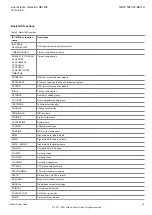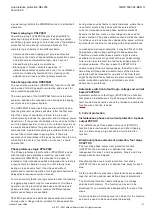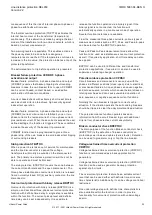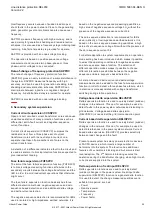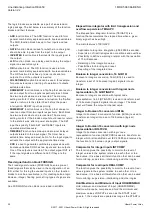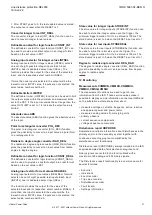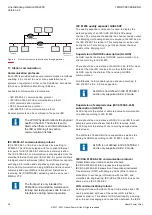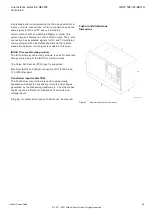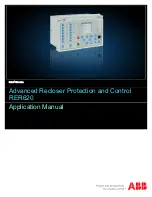
Average Power Transient Earth Fault Protection
APPTEF
GUID-A16ED4BC-855F-4561-8512-B4F30775784F v1
The APPTEF (Average Power Transient Earth Fault
Protection) function is a transient measuring directional
earth-fault protection. Determination of the earth fault
direction is based on the short-term built-up transient at the
beginning of the earth fault. This transient is to a large
extent independent of the neutral point treatment. This
means that the function can be used without any
modification in all types of high-impedance grounded,
resonant grounded or isolated power systems.
For a resonant grounded system, the correct directional
measurement is ensured regardless of how many Petersen
coils are used throughout the interconnected power
network. The function is not sensitive to the actual
compensation degree of the coils. It will operate equally well
in an under- or over-compensated system. Parallel neutral
resistor to the Petersen coil are not needed to correctly
determine earth fault direction. However, these neutral
resistors can still be used if already installed in the network.
The function is suitable to be used in distribution and in
meshed HV sub-transmission networks using high-
impedance grounding. In meshed systems a directional
permissive scheme is required in order to ensure selective
tripping of a faulty line. Alternatively, the function can be
used solely for signaling of the earth-fault location to the
SCADA system when the power network is allowed to
operate for a longer time with an earth-fault being present.
6. Voltage protection
Two-step undervoltage protection UV2PTUV
M13789-3 v14
Undervoltages can occur in the power system during faults
or abnormal conditions. The two-step undervoltage
protection function (UV2PTUV) can be used to open circuit
breakers to prepare for system restoration at power outages
or as a long-time delayed back-up to the primary protection.
UV2PTUV has two voltage steps, each with inverse or
definite time delay.
It has a high reset ratio to allow settings close to the system
service voltage.
Two step overvoltage protection OV2PTOV
M13798-3 v17
Overvoltages may occur in the power system during
abnormal conditions such as sudden power loss, tap
changer regulating failures, and open line ends on long
lines.
Two step overvoltage protection (OV2PTOV) function can
be used to detect open line ends, normally then combined
with a directional reactive over-power function to supervise
the system voltage. When triggered, the function will cause
an alarm, switch in reactors, or switch out capacitor banks.
OV2PTOV has two voltage steps, where step 1 can be set
as inverse or definite time delayed. Step 2 is always definite
time delayed.
OV2PTOV has a high reset ratio to allow settings close to
system service voltage.
Residual overvoltage protection, two steps
ROV2PTOV
M13808-3 v12
Residual voltages may occur in the power system during
earth faults.
Two step residual overvoltage protection (ROV2PTOV)
function calculates the residual voltage from the three-
phase voltage input transformers or measures it from a
single voltage input transformer fed from an open delta or
neutral point voltage transformer.
A reset delay ensures operation for intermittent earth faults.
ROV2PTOV has two voltage steps, where step 1 can be set
as inverse or definite time delayed. Step 2 is always definite
time delayed.
Loss of voltage check LOVPTUV
SEMOD171457-5 v8
Loss of voltage check (LOVPTUV ) is suitable for use in
networks with an automatic system restoration function.
LOVPTUV issues a three-pole trip command to the circuit
breaker, if all three phase voltages fall below the set value
for a time longer than the set time and the circuit breaker
remains closed.
The operation of LOVPTUV is supervised by the fuse failure
supervision FUFSPVC.
7. Frequency protection
Underfrequency protection SAPTUF
M13349-3 v13
Underfrequency occurs as a result of a lack of sufficient
generation in the network.
Underfrequency protection (SAPTUF) measures frequency
with high accuracy, and is used for load shedding systems,
remedial action schemes, gas turbine startup and so on.
Separate definite time delays are provided for operate and
restore.
SAPTUF is provided with undervoltage blocking.
The operation is based on positive sequence voltage
measurement and requires two phase-phase or three
phase-neutral voltages to be connected.
Overfrequency protection SAPTOF
M14953-3 v12
Overfrequency protection function (SAPTOF) is applicable
in all situations, where reliable detection of high
fundamental power system frequency is needed.
Line distance protection REL650
1MRK 506 384-BEN H
Version 2.2
24
Hitachi Power Grids
© 2017 - 2021 Hitachi Power Grids. All rights reserved










